Here are the best SEO Interview Question and Answers from Offpagesavvy. Offpagesavvy is the best database for SEO strategies that always provide genuine and quality content to guide you on the right path. So, here on this page, we are providing a complete useful resource of 100+ SEO interview questions and answers.
Students who completed a digital marketing course might be started preparing for interviews. Here we collected the top 100+ frequently asking SEO interview questions for you. These SEO questions and answers cover all topics from scratch which enhances your theoretical knowledge on SEO. Hence, this SEO interview questions list surely help you to crack the interview to get placed in a good company.
If you are a fresher or else an experienced person don’t neglect to read all these questions. Because this SEO interview questions bank helps you to prepare for beginner and expertise level job interviews in your digital marketing career.
100+ SEO Interview Questions and answers for freshers and experienced DM professionals:
- What does SEO stand for?
SEO stands for Search Engine Optimization.
- What is SEO?
SEO is the process of making sure our website will get a huge traffic in search engine results page.The main objective of an SEO is to get a good ranking in search engine results.
- What is the importance of SEO? or What is the purpose of SEO?
Most of the online users seek help from Google to search for products or services. Because they trust google search results to be more authentic and more relative to a user search query.
And most of them check the top 2 to 5 pages of the search result web pages on the google search. Hence, it is very essential to make a business product or service website available on top search results depending on relevant keywords.
So, SEO helps to improve the ranking of website pages on the top search engine results to drive more traffic and leads to a website or business.
- What do you mean by organic search results?
Organic search results are web pages that are most relevant to the search keywords or queries entered by a user. Generally, these organic results are referred to as “natural” or “free” results.
- What is a search engine?
Search Engine is a software system that searches and recognizes relevant information from the database and makes available related webpages over the internet. These search engines enable searchers to find related data in the form of webpages without any need of technical experience.
- Name a few search engines other than Google?
Bing, Yahoo!, Baidu, Yandex, and DuckDuckGo.
- In which year Google was founded? And who are the founders of Google?
Google was founded in the year 1998. And the founders of Google are Larry Page and Sergey Brin.
- What is a World Wide Web?
World Wide Web (WWW) is simply referred to as Web and generally it is a prefix in a URL. WWW is an information system where web resources and documents are discovered by Uniform Resource Locators (URL) to make available the data over the internet.
Simply WWW is a network of web/internet servers containing information in the form of web pages, videos, audios, etc. Generally, web resources are hosted and stored in a software application called “web servers”. Webpages in these resources are interconnected by links called “hypertext”.
Whenever a user tries to access the resources through a software application called “Web browser”, these resources of www are transferred via Hypertext Transfer Protocol (HTTP).
- What is a Domain Name?
A domain name is nothing but the name of a website. A domain name is like an address for internet users to find and access a website. For example consider a web address www.offpagesavvy.com, in this offpagesavvy is a domain name.
Generally, computers use IP addresses which are a series of numbers to find and identify the websites. So, a Domain name is discovered for easy identification of the resources because it is difficult to remember the long string IP address.
A domain name is a combination of any letters and numbers. Every domain name must be unique. Hence, no two websites can share the same domain name.
- What is a domain extension?
A domain extension is a notation at the end of a web address that is generally used to specify the domain category or country code. The domain extension is also referred to as Top-level domain (TLD).
- Most commonly used general extensions are:
.com for commercial
.edu for educational
.org for organization
.gov for government
.net for network
- Examples for country-code top-level domain extension
.in for India
.uk for the United Kingdom
- What is a website?
A website is a collection of interlinked web pages or formatted documents that share the same domain name and that are accessed over the internet. Websites are identified with web addresses or domain names. When anyone searches with website address over the internet, then it will direct them to the website home page.
- What is a web page?
A web page is a document generally written in HTML code and accessed through a URL address to be viewed in an internet browser. Generally, these web pages are a collection of text, images, audio, video, graphics, and hyperlinks to other web pages or files.
- What is an URL?
URL full form is Uniform Resource Locator (URL). URL is a web address of web resources like websites, web pages, or documents over the internet. It is used to know the location of a resource and domain name as well as a protocol to access. URL generally contains 4 to 6 parts and never be less than 2 parts.
Protocol: It is used to access web resources over the internet. Generally, it may be HTTP or HTTPS that connects to a domain name.
Domain Name: It is the unique name of a website on the web. The domain name connects to the file path. A domain name always includes a TLD domain extension like .com or .net at the end.
Port: It is a port number that is mostly not visible in the URL. When it is visible it is separated by a colon after TLD.
Path: it may be a file or directory of a website on the webserver.
Example:
Subdomain TLD
https://www.offpagesavvy.com/seo-interview-questions
Protocol DomainName path
Hyphens are used to separate the words in a URL.
- What is a web server?
A web server is a computer program with IP addresses and domain names that deliver the web pages in response to user search queries requests. Web servers are used to store and host websites over the internet. Web server accepts and processes the user requests sent via HTTP.
- What is web hosting?
Web hosting is a service to provide storage space for web pages or websites on special software systems called servers. Web hosting allows the user to view the web pages on the web.
For example, whenever you enter a website address on a browser, your computer network connection to the server, and the related web pages are delivered on the browser.
- What is crawling?
Crawling is an automated process by a search engine to verify and filter the web pages for proper indexing.
Crawling can be done by web spiders web crawlers or software robots. These web robots look at each webpage for content, keywords, hyperlinks, and bring back the data to web servers for indexing.
- What is indexing?
Indexing starts once the crawling process finishes during a search on the internet. Indexing can be done according to the type and quality of information on crawled websites. Search engines respond to user queries by going through indexing sites to show the most relevant pages.
- What is SERP?
Search Engine Result Page is a list of relevant web pages on the web when a user raises a query on a search engine. SERP not only presents relevant web pages but also includes advertisements on the list. A list of results contains webpage links that are arranged from higher to lower ranking of the page. The links contain a title and short meta descriptions of the web pages.
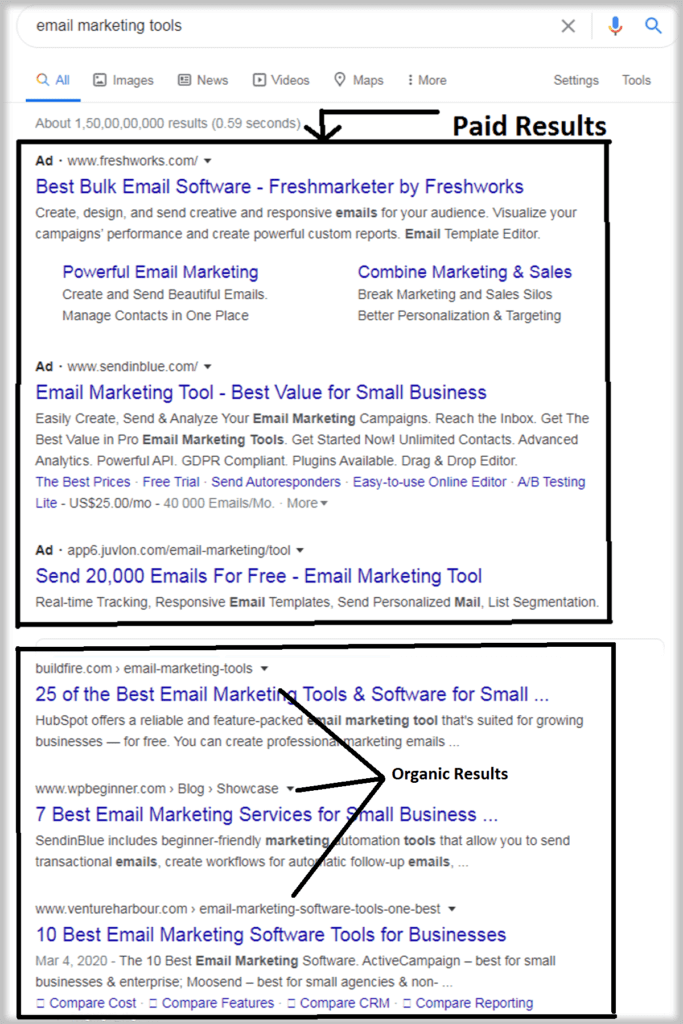
- What are the paid search results?
Paid results are generally advertisements that are visible on top of SERPs. Paid results are quite opposite to organic search results. Many webmasters or business owners make payments to Google to display their website pages on the user search keyword.
- What is Autocomplete or Google suggest?
Google suggests is a section of Google’s search engine auto-complete function. When a user types on the Google search field, Google shows related terms to the user query in a drop-down menu. Such auto suggestions are a collection of the most frequent search queries over Google.
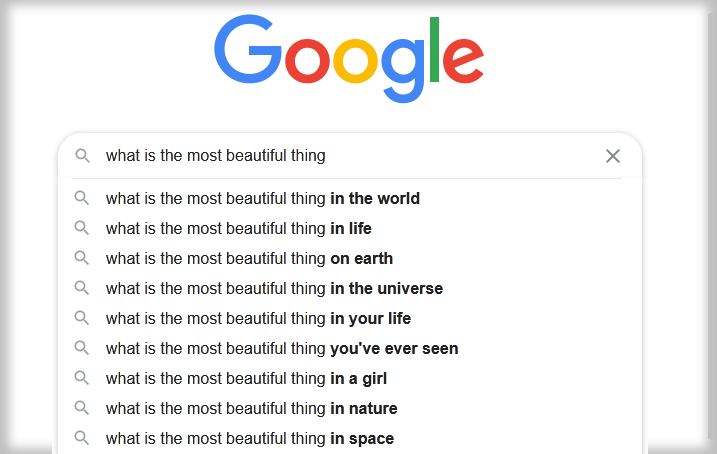
- What is on-page SEO?
Implementation of SEO strategies within a website to get high ranking and huge traffic from search engines is referred to as on-page SEO.
Generally, on-page SEO involves optimization of the content and internal links of the web pages within a website. It also includes optimization of title tags, meta descriptions, meta tags, and heading tags.
- What is the off-page SEO?
Performing SEO methods out of the website boundaries to improve ranking and huge traffic is referred to as off-page SEO.
This method helps you like promoting your business site through content marketing, link building, press release, and social media marketing to improve the ranking of the website in SERPs.
- What is meant by keywords in SEO?
Keywords are essential phrases that serve as a key in SEO. Keywords are included in webpage content that helps the users to find the relevant query response through a specific website over the internet.
- What is a long-tail keyword?
Phrases containing more than 4 words in a keyword to make highly specific search results are referred to as long-tail keywords.
Long-tail keywords are much more helpful than single-word keywords to improve ranking in SERPs. Many SEO professionals use long phrase keywords to drive quality traffic instead of random traffic. Further, it also improves the lead conversion rate.
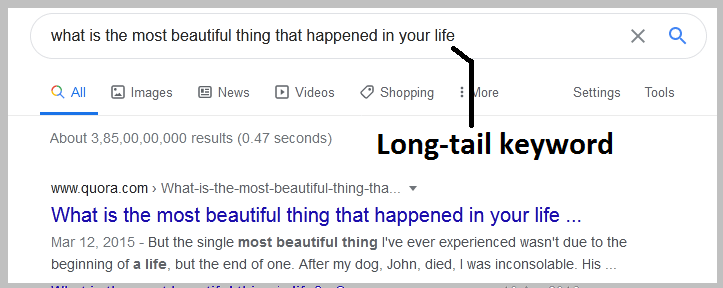
- What are LSI Keywords in SEO?
LSI keywords are words or phrases that are highly correlated with the main keyword of content. LSI keywords are used to improve the online visibility of a website and drive traffic to improve ranking in SERPs.
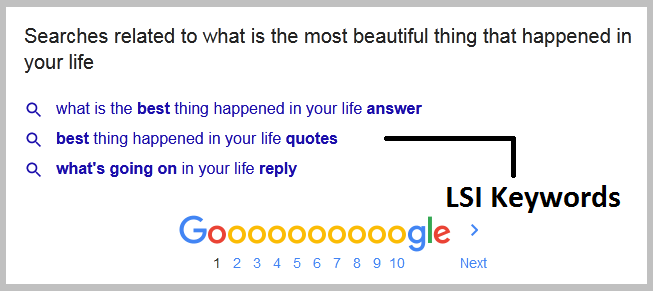
Latent Semantic Indexing(LSI) is a search engine system used to analyze different terms of a specific topic. Google algorithm uses these LSI keywords to decide the relevance and quality content to the search keywords.
You can find these LSI keywords of the main keyword at the bottom of the Google browser section.
- What are Heading tags?
Headings or header tags are used to break the content into several paragraphs to gain user engagement as well as to improve SEO.
Tags serve an important function in SEO practices to create structured content. So that users can easily read the content. And you can also use keywords in header tags for SEO.
There are 6 heading tags to use in the content of a webpage or blog post. Tags from h1 to h6 provide a top-down hierarchy to bring structured quality content. Using consistent and relevant keywords in header tags will boost the web page’s online presence over the internet.
- What is a canonical URL in SEO?
Canonical URL is also referred to as a canonical tag which is a very important part of SEO strategies. Canonical URL is an HTML element that helps search engines to discover more relevant or standard resources to avoid duplicate content issues.
If you have different pages with similar content or else if a webpage is accessible by many links then you can select one canonical URL as the best one out of several URLs. When one webpage is marked with a canonical URL then other copied content webpages are considered as variations of canonical version by the search engines. Hence in this way, the canonical URL avoids content duplication problems.
- What is a page title?
A page title is also referred to as a title tag which is an HTML element generally used to indicate the title of the page. It is the most important tag among all the meta tags. The title tag is generally displayed in search engine results as a clickable title just above a URL.

Always use a unique and relevant title that matches the content of the web page to drive traffic to your site. Title tags enable users and search engines to know the nature of information on a web page. Use effective primary keywords in the title tag so that search engines can easily analyze it rank your web page.
- What is SEO friendly URL?
The URL which is used to optimize the usage and structure of the words in the URL is considered an SEO-friendly URL.
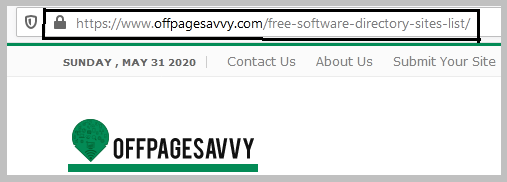
Using proper and effective target keywords in the URLs helps to gain high rank and traffic for the website. Always use short and simple URLs to make easy understanding for users and search engines.
- What are meta descriptions?
Meta descriptions are also referred to as HTML attributes that provide a short and precise note of web page content. These meta descriptions will look like preview snippets of a web page under the URL of a webpage in the SERPs.

Relevant information in the meta description grabs user attention towards your website. Hence, these meta descriptions enhance the promotion of the website and also improve Click-through rate(CTR) of the webpage.
- What are the limitations of the title tag and meta description tag?
The title tag must be in a range of 50 to 60 characters. Because Google displays 50 to 60 characters length of a title tag. So better to use 60 characters of the title tag in a webpage title to get displayed properly in SERPs.
In the same way, the Meta description must be in a range of 155 to 160 characters in length. Because generally, search engines display the first 160 characters’ description of the webpage in search engine results.
- What is Link Building in SEO?
Link building is the best practice of off-page SEO to get a link from other websites to your website. Link building is very essential for SEO because it notifies search engines that your website is quality and worthy resource.
- What is a backlink?
A backlink is a simple link from one website to another website. Through this backlink, users can be shifted from one website to another. Backlinks play an important role in SEO. Backlinks are also referred to as inbound links, incoming links, inlinks, or inward links.
Google algorithms validate the quality of multiple backlinks of a webpage to consider the page as the more relevant page to the user search query. In this way, backlinks help in easy indexing of a website as well as improves the ranking of the page on SERPs.
- What is internal linking?
Internal linking is a method of providing a hyperlink to a text in webpage content that connects to another webpage of the same website or domain. These internal links direct users to move from one page to another of the same domain. Hence these internal links help you to drag user interest that further improves user engagement in your site.
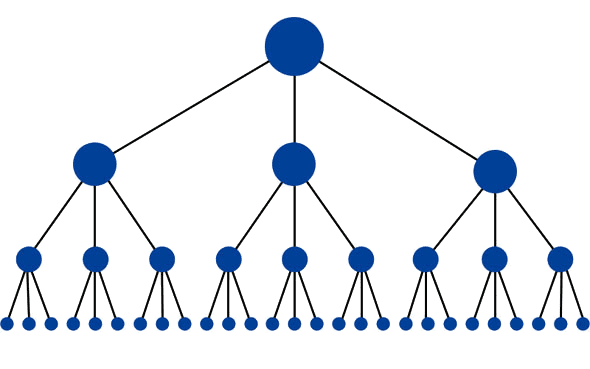
Also, link juice will pass from one page to other linking pages.
- Why internal links are important?
Internal links are more important in on-page SEO. These links are useful in many ways, such as:
Improves user engagement: Through these internal links, users can shift from one page to other pages or blog posts. hence, it enhances users’ experience in a website that makes normal customers into potential customers.
Provide website structure: having internal links on a website helps search engines to crawl and index your website easily and fastly. Crawlers or web robots can use these internal links to validate your website and further improve ranking in SERPs.
Minimize the bounce rate: Internal links makes visitors stay for a long period of time on the website. This helps in reducing site bounce rate and improves potential customers and leads.
- Differentiate between inbound links and outbound links in SEO?
Inbound links or backlinks are the incoming links to your website from other websites or external sources. Whereas, an outbound link is a link that points from your site to other sites.
Ex: if you get a link from offpagesavvy.com to your domain. Then this link from offpagesavvy.com is a backlink or inbound link to your domain. Although the same link will be the outbound link for offpagesavvy.com
- What is a dofollow link?
Dofollow links allow all search engine bots to follow them and reach the website. Dofollow backlinks pass the link juice from another referral website to the linked website. So, crawlers count these link points to decide page rank. The higher the link juice the greater will be the page rank and search engine ranking of the webpage.
- What is a nofollow link?
Nofollow links enable search bots to ignore the link. Nofollow links do not pass any link juice and do not improve the page rank. So, these links do not affect the search engine ranking of a webpage.
By default, all the backlinks are do-follow links unless they are changed to nofollow links automatically or manually by a website setting. Search engine bots follow the dofollow links. But whereas nofollow links tell search engine crawlers not to follow them. humans can follow them if your content is good and attractive.
- Why Outbound links are important in SEO?
Outbound or outgoing links are the links that direct users from your webpage to another webpage or website. outbound links have great importance in SEO because they improve the quality as well as the value of the webpage for search engine ranking. Simply search engine counts outbound links as the third-party votes that help to improve website ranking in SERPs.
- Why backlinks are important in SEO?
Generally, random backlinks do not offer much help but quality backlinks offer great value to your website or webpage. The backlink that comes from the content-related web page of another site to your page will be considered as a relevant or quality backlink by the search engines. Otherwise, the backlinks from the unrelated content webpage are considered irrelevant backlinks that impact greatly in reducing your site authority. Quality backlinks add great worth to your site visibility online and give a positive impact on website ranking in SERPs. Hence backlinks are more valuable in SEO.
- Name the most important Google ranking factors?
Some main factors that affect Google search engine algorithm are:
- Quality content
- Quality Backlinks
- Rankbrain
- Page load speed
- Mobile-friendliness
- How does Google ranking works?
Google uses many algorithms to rank a website in search engine results. With the help of its algorithms, it will be easy to find relevant webpage results to the user keywords in google search.
Google always updates its ranking factors to provide better results to improve its user experience and also to verify black hat SEO practices. Hence, Google considers ranking factors to display highly relevant results to the user.
- What is an HTML sitemap?
The first sitemap means the map of a website that gives a detailed structure of a site with different sections through internal links.
An HTML sitemap comprises one single HTML page that holds all webpages links of the website. HTML sitemaps contain all formatted text files and internal linking tags of the website. This sitemap is like a foundation for all web pages on a website.
It is mainly useful for a website with a large number of multiple web pages. So that listing all web pages in one place helps easy navigation of the site to improve user-friendliness.
- What is an XML sitemap?
An XML sitemap is mainly designed to smooth search engine functionality. XML informs the search engine bots about the number of web pages, frequency of the website pages updates, and last updating details. All this information helps search engine bots to index a website.
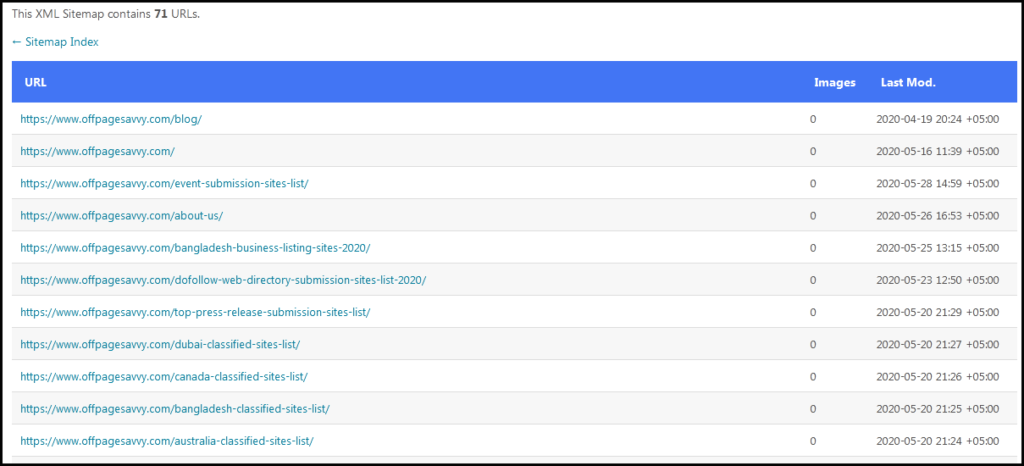
- How do you know what pages are indexed by Google?
There are two different ways to check what pages are indexed by Google.
The first one is to use Google webmaster tools to check the Google index status of a website. To know the index status you need to add the website on a dashboard and verify ownership. Then you can click on the “Index Status” tab to know the number of web pages indexed by Google.
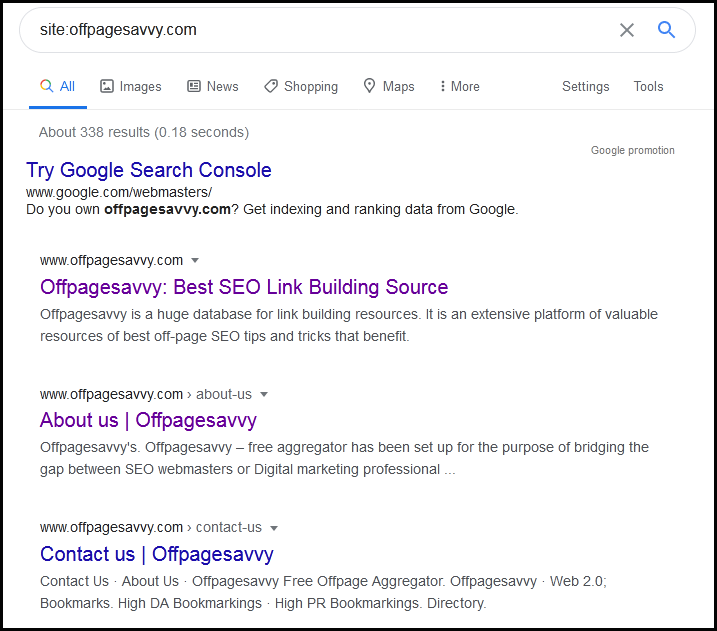
And the second one is to do a manual search on Google. To verify in this way we need to type on Google search field like site:domainname.com. Then indexed web pages will show in the SERPs.
- What are the doorway pages?
Doorway pages are also referred to as gateway pages, entry pages, or portal pages that are mainly created to improve ranking the website pages in SERPs. The doorway pages direct the visitors to relevant and useful sections of the site.
Hence, these pages act as a gate between users and the main page. Black hat professionals use these doorway pages to improve the website ranking in SERPs for specific keywords or queries are entered.
- What is the use of anchor text?
Anchor text is clickable text written on a hyperlink. When a user clicks the anchor text, it takes a user to a specific section of a webpage. Webmasters can use the anchor texts and tags in a single webpage instead of splitting web documents or creating different web pages.
These texts provide easy navigation for a user on a single page instead of moving to other pages. In this way, it helps to gain user interest and also brings more user engagement to a webpage.
- What is an image alt text?
Image Alt text or alternate text is an attribute added to an image tag in HTML. Whenever there is a failure in displaying an image then image alt text will be appeared to ensure what the image is about.
Web crawlers consider it as alternative text to an image to index the webpage for having the image. Using proper alt tags adds value to user experience and also improves the SEO ranking of a website image in google search image results.
- What are the basic tools required for SEO?
Basic and free tools which are most commonly used by webmasters or SEO experts are:
- Google webmaster tools
- Google Analytics
- Google Keyword Planner
- Google ads
- Moz
However, there are many paid tools that are readily available in the market for SEO. Most used paid tools for SEO purposes are:
- Seo Moz
- Semrush
- Ahref
- What is Google webmaster tools or Google search console?
Google search console offers free web services for webmasters to monitor and sustain the online visibility of their specific websites. It is the most useful tool for SEO. It is mainly designed to help the webmaster to know some issues like crawling errors, index status, backlinks, malware issues, etc.
Google changed the “Google webmaster tools” name into “Google search console” on 20th May 2015.
- What is Google Analytics?
Google Analytics is a freemium web service offered by Google that helps webmasters track and monitor website traffic. It gives detailed statistics of website visitors, visitors’ activity and dwell time, incoming keywords, etc. Google analytics tools help to understand and analyze the business and customers in one place. This statistical information helps you take the necessary steps to improve the performance of the website to survive in online marketing.
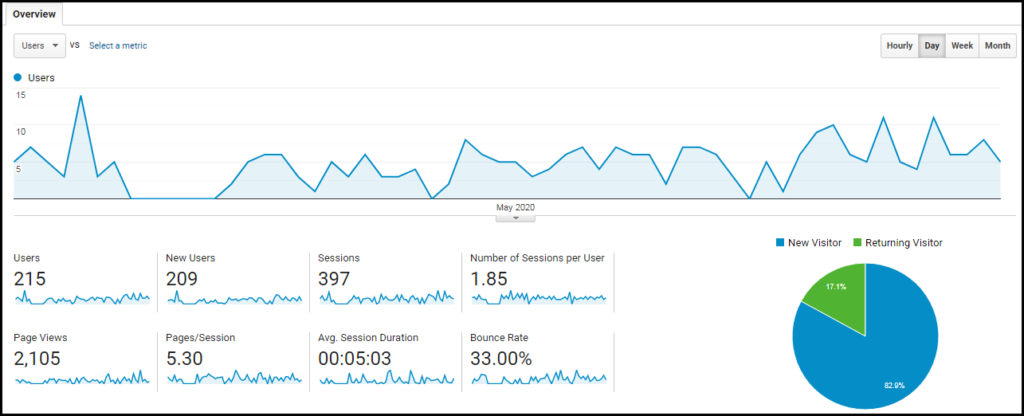
Google Analytics provides four different analysis reports:
- Audience Analysis: Overview of visitors’ information and their activity on your site.
- Acquisition Analysis: It helps you to understand the sources of your website traffic.
- Behavior Analysis: It helps you to monitor users’ behavior.
- Conversion Analysis: It gives information on generated leads, targeted traffic, or products or services.
- What is domain authority?
Domain Authority is a key metric developed by Moz that is the most important influencing factor in SEO. DA is designed to rank a website on a scale of 1 to 100. Greater the rank then greater traffic and higher the visibility of a website on SERPs. Domain Authority adds credibility to a site. Highly relevant and quality backlinks improve the Domain Authority of a site. The strength of domain authority defines the ranking of a website in search engine results.
- What is Google PageRank?
PageRank is one of the most important ranking factors considered by Google. Search engine like Google ranks a webpage by considering the quality and quantity of backlinks. The page with higher backlinks has a high PageRank than a page with lower backlinks.
- What would you do to improve the PageRank of a webpage?
Many factors like quality content, quality, relevant backlinks, and SEO strategies help in improving the PageRank of a webpage. The PageRank of the webpage reflects the performance of your webpage SEO. Always include unique and genuine content, create more backlinks from high domain authority sites to improve the PageRank of a webpage.
- What is Google Algorithm?
Google algorithm is a set of rules, commands, or code that provides relevant search results according to user queries. Google search engine uses these algorithms to rank the web pages on SERPs by verifying the relevancy and quality of the web pages over the internet.
- What is Google Panda?
The change or update in the Google algorithm is referred to as Google Panda. The term Google Panda was coined in the year of 2011 to recognize high-quality sites on top of SERPs and to lower the rank of “thin-content” sites or “low-quality” sites. The earlier Google panda is called “Farmer”.
Google considers many issues to consider a site as a thin site. The factors are Duplicate content, low-quality content, low authority, etc. The main focus of Google panda is finding low-quality or spammy sites and penalizing them if possible.
- What is Google Penguin?
Google Penguin is the update in the Google algorithm to enhance the authority of search results on SERPs for user queries. Google Penguin was introduced in the year 2012, it mainly focuses on bad-linking sites and keyword stuffing or over-optimized sites.
The Penguin targets the sites mainly that practice black-hat SEO. This algorithm also rewards high-quality sites that practice white-hat SEO strategies.
- What is Google Hummingbird?
Google Hummingbird is a codename given to an important algorithm change in the year 2013. This update mainly focuses on the speed and precision of search results that catch users actual search intent and find the best matches to the search intent. The significant importance of Google Hummingbird is refreshing the Google index as well as its search engine.
- What is Google Pigeon Update?
Google Pigeon update is a codename given to google search algorithm update in the year 2014. It mainly focuses on increasing the ranking of local listings in search results. The changes also affect search results related to Google Maps as well as regular search results in Google.
- What is Mobilegeddon?
The term Mobilegeddon is given for the Google algorithm update in 2015. This update enables higher priority to the websites that display well on mobile devices or smartphones. Google uses mobile-friendly testing tools to test the web pages for mobile friendliness.
- What is Google Penalty?
Google Penalty is a negative impact on website search ranking based upon the changes in google algorithms or manual reviews. If the penalty is raised manually then it informs through the Google webmaster tool. If it is an automatic penalty due to algorithm update or for using black-hat SEO technique then it may not be informed. Generally, the Google penalty will be done in three different ways: Rank Demotion, Bans, and temporary rank change.
- What is Google Sitelinks?
Google Sitelinks are the sub-listings that are sometimes visible under the first listing on the first webpage of Google search results. Google uses automated algorithms to shortlist and display sitelinks. Google specifies sitelinks only if it thinks that the sitelinks are useful for the user. These sitelinks provide hyperlinks to website subpages under the main page for easier navigation to the site.
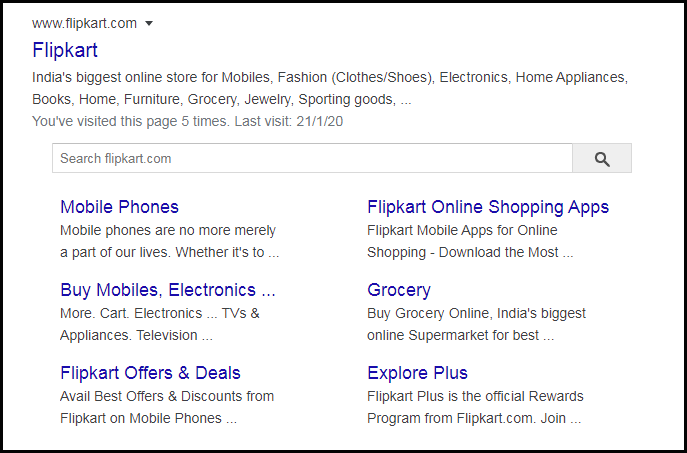
- What is Google Knowledge Graph?
Google Knowledge graph is mainly used to enhance its search results with systematic information gathered from different sources. It interconnects many kinds of search results to create an information box that appeals to more effective, accurate, relevant, and structured. So, it enhances organic search results as it gathers and understands the data about places, people, objects, etc.

Google Knowledge graph will impact a positive effect on SEO as well as on user experience. Through these Knowledge Graphs, users will be able to get more qualitative and relevant search results, and a website SEO gets more traffic for informative content.
The information from the Knowledge Graph is represented in a box on the top right side of the Google search results page which is referred to as Knowledge Panel or card.
- What is Google Sandbox?
Google Sandbox is like an alleged filter that does not allow new websites or low authority sites to display in search results. Even if the new site has good content with important keywords or phrases, it may get affected by the sandbox effect. The sandbox effect may be caused due to too much link building within a short period of time. Generally, a website may be in the sandbox effect for one to six months.
- What is Google My Business?
Google My Business is a free and easy-to-use tool offered by Google. It is mainly designed to help organizations, artists, brands, businesses to create and manage their business listing on Google including search and maps. After writing all details to create Google My Business profile, then the information is verified to make visible on search engine results.
Google My Business helps you to manage your online presence over Google to get easily found by customers as well as to make them understand your business. Although you provide all the required data(Business details link location, phone no, timings) for the local search listing, it also supports you to connect with Google+ page, Adwords Express, and Google Analytics.
- What is an SEO Audit?
SEO audit is a process evaluation of website visibility on search engine results. It rewards a site for its ability to be available in SERPs. It helps you to know if there are any issues on your site. So, you can resolve the issues to boost the ranking of web pages or improve lead conversions. Examples of SEO audit tools are Woorank, SEOptimer, uberSuggest, Website Grader, etc.
- What is Google’s Rich Answer Box?
Google’s rich answer box is a new feature that offers searchers direct answers to their queries in a box format that is available on top of the SERPs. Generally, the main forms of the Rich answer box are:
- Answers provided by Google
- Featured Snippets – Answers from third party sites
- Basic snippets – regular web search results
- Other forms – Rich answers may include schedules, scores, charts, sliders, etc.
- How to get your content featured in Google Rich Answer Box?
There are some effective methods to get the content featured in rich answers, such as:
- Select user highly searched topics
- Recognize queries related to your niche
- Build related answers to engage readers
- Provide detail supplemental information
- Maintain quality and unique form of content
- Keep well-formatted and structured content
- Implement schema markup code
- What is Schema Markup?
Schema markup or structured data is a code implemented in web pages to enable search engines to provide more relevant and informative results for users. It helps the search engines for better understanding about our site, also to recognize and classify the information to highlight the content in a rich snippet format. Schema code generally does not affect any crawling process. But it changes the representation of data to be displayed in search results. Therefore it makes search engines understand the intent of page content instead of just informing what it says.
- What is Cloaking?
Cloaking is a black hat technique for SEO that presents content to search engine crawlers is different from that displayed to the user’s browser. Cloaking is done with certain keywords or phrases to boost webpage ranking in search results. But this practice is against the guidelines of Google.
- What is keyword density?
Keyword density is the percentage of keyword frequency of a webpage to all the words on the webpage. keyword frequency refers to the number of times a keyword or phrase appears on a webpage. There is no ideal keyword density for improving the ranking of a webpage. But generally, keyword density of 2 to 4% is considered good for SEO.
- What is keyword stuffing?
Keyword stuffing is a black hat SEO technique in which keywords are placed in meta tags, backlink anchor text, or visible content beyond a limit to achieve high ranking in search results. Even though web crawlers consider keywords to index a webpage, this practice of keywords stuffing is against google’s guidelines. So, better to avoid this type of SEO technique.
- What is the Disavow tool?
Disavow tool is a part of the Google search console that offers websites to reduce the value of the backlink to save from link-based penalties. Using this tool, you can avoid certain links to be considered while ranking a site. Because low-quality backlinks may reduce your site reputation and harm site ranking. So, you can use this tool to inform Google not to consider some backlinks while crawling or indexing the site.
- What is Google fetch?
Fetch as Google is a Google search console feature that enables you to test how Google crawls a URL on your site. It also allows you to manually submit web pages for immediate indexing and lets if any issues with the pages or site. If any raise of technical error like 404, 500, 503, then you can easily submit the page for a fresh crawl using this feature tool.
- What is a 404 error?
A 404 error is an HTTP standard response code that informs the user-requested webpage that is not found on the server. This error is displayed as a webpage across an internet browser window. Actually, Google doesn’t penalize a website for 404 errors. But these broken links make a bad user experience.
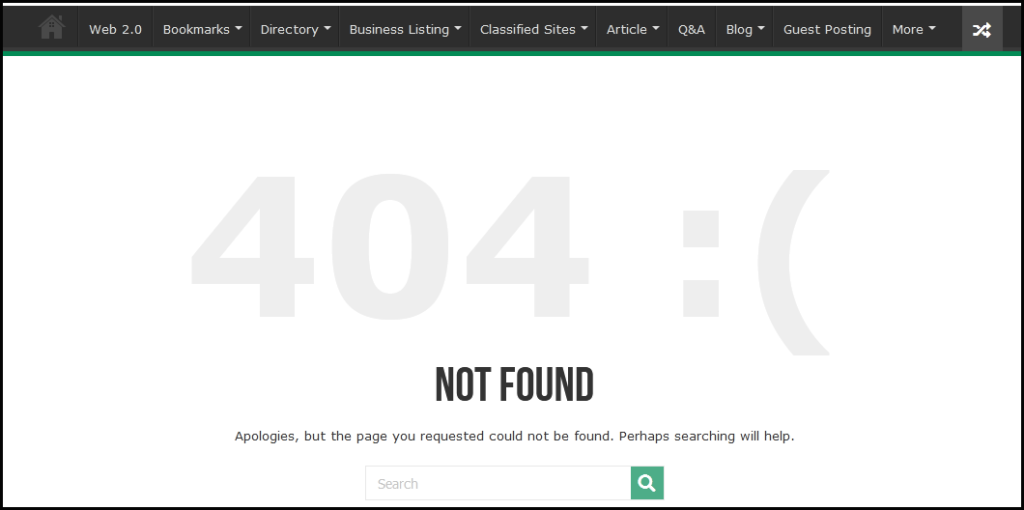
- What is the 503 error?
The 503 services unavailable error is an HTTP response code that simply indicates the website server is not available at that moment. Generally, it is a temporary state that is resolved in a short time. It usually occurs when a server is too busy or else when maintenance is performed on a site.
- What is the 500 error?
The 500 error is an internal server-side error is an HTTP status code that indicates some issues that occurred on the website server but the server is unable to find what the exact problem is.
- What is robot.txt?
The robot.txt file is a text file that informs search engines to crawl which web pages. And it also tells which pages not crawl. Search engines follow instructions in the robot.txt file to crawl and index the web pages of a site.
The file must be placed in the main directory of a site because web robots only check the main directory rather than checking a whole site. If the web robot is not able to find the file in the main directory then it assumes that the site doesn’t have any robot.txt file and crawls the whole site.
- What is 301 redirect?
The 301 redirect is an HTTP status code that indicates the webpage is moved permanently to a new location. This method of redirecting search engines as well as users from an old URL to a new URL page. With this 301 redirect search engines pass link juice to the new web address. And search engine also passes all the associated values like domain authority and page ranking with the old site to a new website.
- What is Social Networking?
Social networking is a system of improving the number of business or social contacts by connecting with other individuals through social media platforms like Facebook, LinkedIn, Twitter, Instagram, Pinterest. Social Networking sites provide a great platform for SEO practices to gain user traction and leads.
- What is AMP?
Accelerated Mobile Pages(AMP) is an open-source HTML framework developed by AMP open-source project. The main aim of AMP is to optimize a website for mobile web browsing and also to make faster loading of webpages. This framework makes mobile pages easily readable and faster loadable for a good user experience. This project is jointly introduced by Google, Adobe, WordPress, etc.
- What are contextual backlinks?
Contextual backlinks are the links to external websites that are embedded within the main or primary content of a webpage. Generally, these links are built from high-authority websites. So, it is very hard to get these backlinks. These links are much more powerful than any other links.
- What is black hat SEO?
Black hat SEO is a set of strategies that disobey search engine rules and guidelines in order to improve page rank.
- What are some techniques of Black hat SEO?
Some of the most implemented Black Hat SEO techniques are:
- Duplicate Content
- keyword Stuffing
- Hidden Text
- Doorway Pages
- Article Spinning
- Cloaking
- What is Article spinning?
Article spinning is one of the black hat SEO techniques to improve the SEO of a website. Article spinning is a practice of making different copies of a single original article where each copy is treated as a new article. These articles have repetitive and low-quality content. And uploading these articles frequently on a site to make them like fresh articles.
- What is keyword stemming?
Keywords stemming refers to Google’s ability to understand different forms of a specific search keyword. It is also called stemming because finding a base or root word of a search query and then creates new keywords just by adding prefix or suffix to the root word. This method of practice offers to enlarge the keyword list and thus boost traffic.
- What is referral traffic?
Referral traffic means the viewers who come from other sites to your site without searching on the Google search engine. In simple words, the visitors directed from other domains to your domain are called referral traffic.
You can gain referral traffic by creating links on other sites, blogs, forums, etc. This traffic is coming from outside of the search engine. So, Google tracks such types of visiting referred to as referral visits or traffic.
- What is the RankBrain algorithm?
RankBrain is part of the Google core algorithm which makes use of a machine learning system to provide the most relevant search results to the user queries. It can learn and identify new patterns to offer more relevant information.
- What is Alexa Rank in SEO?
Alexa Rank is the most considerable metric in SEO that ranks websites in a specific order on the basis of site popularity and website traffic in the last three months. Alexa rank is updated on a daily basis analysis. A site with a lower Alexa rank is considered the most popular site.
- What is the bounce rate?
The bounce rate is a percentage of the number of viewers who visit a particular website and leave the site after viewing a single page rather than continuing to other web pages within the same site. Google Analytics informs the bounce rate of a webpage or a website.
The bounce rate is also defined as a percentage of the number of single-page sessions to the whole number of all sessions. The bounce rate describes how the visitors are finding a site. If the bounce rate is too high, then it tells your site does not contain relevant information or the information is not useful for the visitors.
- What is PPC?
PPC stands for pay per click. It is a method of internet marketing in which you have to pay some amount each time your advertisement is clicked by an online user. Popular search engines like Google, Bing offer PPC advertising on a trade basis where the site highly bids gets prominent advertising space on SERPs so that it gets more clicks.
- What is CTR?
Click-Through Rate or CTR is the ratio of users who click a specific link to the number of total users who view a page, advertisement, or email. It is an important metric that measures the success of an internet advertising campaign for a specific website and tells the effectiveness of email campaigns.
- What is a Robots Meta Tag?
Robots Meta Tag is mainly used to provide instructions to the web spiders. It informs search engine bots how to treat a page’s content. It is a simple code that is embedded in the head section of the webpage. Follow, NoFollow, Index, Noindex are some of the parameters involved in the main meta tag.
The simple syntax of a robot meta tag:
<meta name=?robots? content=?instructions for crawler?>
- What is the hidden text?
Hidden text is one of the black hat SEO techniques to improve site ranking. The hidden text is also known as invisible text, is the content that is not visible to viewers but it can be read by search engines. Using this hidden text is against the rules of search engines. The search engines can ban a site if it found hidden text on a webpage.
- What is keyword proximity?
Keyword proximity is a measure of the distance between two keywords or phrases. It describes how close two keywords are in content. If two keywords are closer in a phrase, then it is considered a more relevant phrase. Hence, Search engines make use of keyword proximity to provide more relevant search results for user queries.
- What is link popularity?
Link popularity means the number of backlinks that come towards a site. Generally, backlinks can be internal or external links. High link popularity tells that more visitors are connected to your site and think the site is providing useful information to the user. Popular search engines consider link popularity in their algorithm to rank a website in SERPs.
- What is HTTPS?
Hypertext Transfer Protocol Secure (HTTPS) is a protocol that provides secure communication over the internet. HTTPS is a secure version of HTTP. HTTPS is formed when a Secure Sockets Layer(SSL) is added to the standard HTTP connection. Most of the sites prefer HTTPS over HTTP because the connection provides website authentication, data integrity, and data encryption.
- What do you mean by a Blog?
The blog is a regularly updated webpage on a website, usually written in an informal or conversational style by an individual or a small group of people. A blog may be written for personal use or to share useful information with a specific group to engage the audience. Bloggers may use pictures, videos, or graphics in webpage content. The bloggers can give access to private or public by their interests.
- State some differences between on-page SEO and off-page SEO?
On-page optimization is done by making changes in the title tag, meta tags, webpage content, site structure, robots.txt, etc. Whereas off-page SEO is mainly focused on creating backlinks and online promotion on social media platforms.
On-page SEO involves optimizing the page elements such as Page title, canonical URL, Page description, Open graph tags, Paragraph text, Page headings and subheadings, Alt image tags, internal and external links.
Some of the main Offpage SEO techniques are Link Building, Social media, press release, blogging, etc.
- Explain some most using Off-page SEO techniques?
Search engine submission: Submitting your website or blog site URL to various popular search engines.
- Directory Submission: Submitting your site to web directory sites that related to a specific niche. This helps in building more backlinks.
- Article submission: Submitting articles in popular article submission sites. But always prefer to submit articles in related sites to your site.
- Press release submission: Prepare a press release content about upcoming events, products, or services of a business or a site and submitting to it to press release sites.
- Classified ads: It is a method of online advertising to promote your site or business products or services in classified sites.
- Forum posting: Participating in forum discussions to build backlinks in forum submission sites.
- Business Directory: Business listing in various directory sites is to promote business in local and global cities.
- Social bookmarking: Creating and storing links on social bookmarking sites to boost link building.
- RSS feed: Submitting RSS feeds to RSS submission directory websites to improve SEO
- Guest posting: Posting an article on a specific topic in other sites as a guest is referred to as Guest posting.
- Blog commenting: Creating backlinks by writing comments in other blog pages or blog commenting sites
- What is a web crawler?
A web spider is also known as a web crawler. It is a robot that will have an automated script or a program that browses the world wide web in a systematic way to index the web pages or website. This whole process is called web crawling or spidering. Search engines use web crawlers to create and update their indexes.
- What is the difference between SEO and SEM?
Search engine optimization is a part of SEM which boosts organic traffic to a site. SEO is a set of practices for increasing online presence, organic traffic to a website, thus improving site ranking in SERPs. SEO can be done in two ways one is on-page SEO and the other one is off-page SEO.
Search engine marketing includes both SEO as well as paid search. SEM uses PPC listings and advertisements to drive traffic to reach the targeted audience. It is an important online marketing strategy that involves buying some space on the search engine result page. This method uses PPC payment which means you need to pay when a visitor clicks on your advertisement.
- Which type of website is good for SEO practices purpose?
It is always better to consider the website with HTML for SEO purposes because it is hard to parse content in the flash website by the search engines.
- Where you can embed keywords for SEO purposes?
More important areas where we can include keywords for on-page SEO are Page title, Anchor link, Meta title, Meta description, content, image alt tag, and headings or subheadings.
 Offpagesavvy Free Offpage Aggregator
Offpagesavvy Free Offpage Aggregator
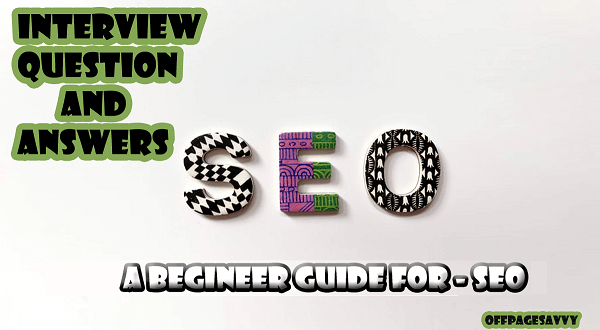
thanks for the great info